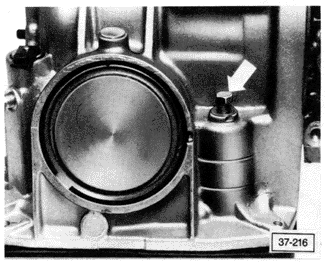Pressure Test
A main pressure test will reveal internal leaks, sticking control valves, or other troubles in the hydraulic controls. Although the full-throttle part of this test can be performed while driving the car, whenever possible this test should be carried out on a dynamometer. The pressure gauge should have a range of at least 0 to 15 bar or 0 to 200 psi, and a hose long enough to allow it to be read from the passenger compartment. Engine idle speed must be correctly adjusted.
To test:
| 1. | Connect the pressure gauge to the main pressure tap on the transmission, as shown in Fig. 3-1. Route the hose so that the gauge can be read from inside the car. |
| Fig. 3-1. | Main pressure tap on transmission case, located on rear of transaxle near driver's side drive axle flange. |

|
| 2. | Drive the car to warm the engine and transmission to normal operating temperature. Stop the car and set the parking brake. |
| 3. | Place the selector lever at D. With car stationary and idling, the main pressure should be between 2.90 and 3.00 bar (41 and 43 psi). |
| 4. | Place the selector lever at R. With the car stationary and idling, the main pressure should be between 9.00 and 10.00 bar (130 and 145 psi). |
| 5. | Either on a dynamometer or during a road test, with the selector lever at D, and the speedometer indicating a speed over 25 mph (40 km/h), floor the accelerator. During full-throttle acceleration the main pressure should be between 5.85 and 5.95 bar (85 and 86 psi). |
| 6. | Shut off the engine. Disconnect the pressure gauge hose and reinstall the plug for the pressure tap. Torque the plug to 10 Nm (87 in. lb.). |
Any pressure that is higher or lower than specification usually indicates a malfunctioning valve body and valves, probably due to contamination. The valve body can be removed, cleaned, and reinstalled with the transaxle in place by removing the ATF pan and strainer. However, it contains many precision parts which must be reassembled in their exact locations. Because of the complexity of the valve body assembly, we recommend that these repairs be left to an authorized Volkswagen dealer or other qualified repair shop.
Low pressure may also indicate a worn ATF pump or internal ATF pump leaks past seals, gaskets, and metal mating surfaces. These repairs require that the transaxle be removed and disassembled.
